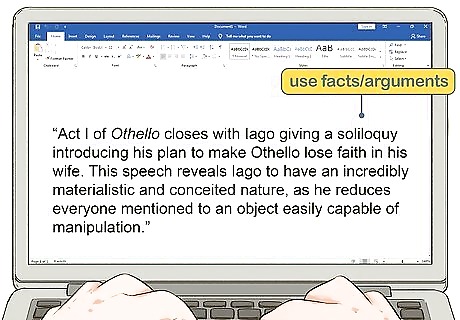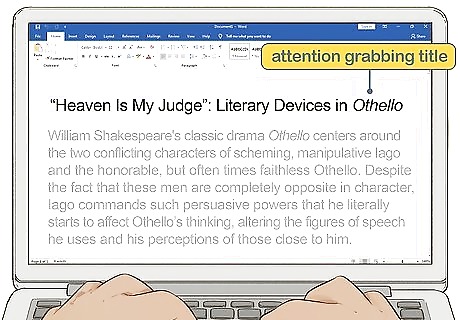
views
Researching & Outlining

Read the syllabus and guidelines. When you receive your assignment, carefully read all the instructions to make sure you understand the goal of your paper, as well as any style and formatting requirements. If anything is unclear, ask your instructor about it. In most cases, a term paper is an analytical, research-based paper used to gauge your comprehension of the course. Think of your term paper as the bridge between what you’ve learned in class and how you apply that knowledge to real-world topics. For example, a history term paper may require you to explore the consequences of a significant historical event, like the Civil War. An environmental science class, on the other hand, may have you examine the effects of climate change on a certain region. Your guidelines should tell you the paper’s word count and formatting style, like whether to use in-text citations or footnotes and whether to use single- or double-spacing. If these things aren’t specified, be sure to reach out to your instructor.

Choose an interesting topic. If your instructor allows you to choose your own topic, take advantage of the opportunity and select something you’re particularly interested in. This will make the term paper easier to write because you already want to know the answers to your questions. Make sure your topic isn’t too broad. For example, if you want to write about Shakespeare’s work, first narrow it down to a specific play, like Macbeth, then choose something even more specific like Lady Macbeth’s role in the plot. If the topic is already chosen for you, explore unique angles that can set your content and information apart from the more obvious approaches many others will probably take. Try not to have a specific outcome in mind, as this will close you off to new ideas and avenues of thinking. Rather than trying to mold your research to fit your desired outcome, allow the outcome to reflect a genuine analysis of the discoveries you made. Ask yourself questions throughout the process and be open to having your beliefs challenged. Reading other people's comments, opinions, and entries on a topic can often help you to refine your own, especially where they comment that "further research" is required or where they posit challenging questions but leave them unanswered.

Do your research. It’s important to research your topic before you launch into writing your term paper, as you need to understand the topic’s background, current thinking, and what future research is considered necessary in that area of study. When researching, use both primary (original text, documents, legal cases, interviews, experiments, etc.) and secondary (other people’s interpretations and explanations of the primary source) sources. Make note of anything relevant to your research question. For example, if you’re writing a term paper about Macbeth, your primary source would be the play itself. Then, look for other research papers and analyses written by academics and scholars to understand how they interpret the text. While it may be tempting to rehash information you already know, try to find information you’re not familiar with instead so you learn something new from the research and writing process. Go into research with a sense of adventure and an openness to learning new things, as well as being ready to discover new ways of looking at old problems.

Craft your thesis statement. After you’ve done the research, reflect on your chosen topic. Pinpoint the single, strong idea you want to discuss. This needs to be an idea you’re certain you can defend throughout the paper and provide a sound conclusion for. Remember, your thesis statement is the spine of your essay—the main idea all your body paragraphs will tie in to—so choose a thesis statement that’s both strong and interesting so you’ll have no problems backing it up. For example, if you’re writing a paper about Lady Macbeth, your thesis could be something like “Shakespeare’s characterization of Lady Macbeth reveals how desire for power can control someone’s life.” Remember, your research and thesis development doesn’t stop here. As you continue working through both the research and writing, you may want to make changes that align with the ideas forming in your mind and the discoveries you continue to unearth. On the other hand, don’t keep looking for new ideas and angles for fear of feeling confined. At some point, you’re going to have to say enough is enough and make your point. You may have other opportunities to explore these questions in future studies, but for now, remember your term paper has a finite word length and an approaching due date!

Develop an outline for the paper. Think of your outline as a road map—it helps you know how to get from point A to point B. Like the rest of your paper, the outline is not set in stone, but it does provide you with a sense of structure and a framework to fall back on when you lose your way mid-paper. It also serves as the skeleton of your paper, and the rest is just filling in the details. There are different approaches to developing an outline and what you need to include may vary depending on the course and assignment. In general, however, here are some basic elements an outline should include: Abstract: An abstract is a concise summary of your paper that informs readers of your topic, its significance, and the key points you’ll explore. It must stand on its own and make sense without referencing outside sources or your actual paper. Introduction: The introduction establishes the main idea of your paper and directly states the thesis. Begin your introduction with an attention-grabbing sentence to intrigue your readers, and provide any necessary background information to establish your paper’s purpose and direction. Body paragraphs: Each body paragraph focuses on a different argument supporting your thesis. List specific evidence from your sources to back up your arguments. Provide detailed information about your topic to enhance your readers’ understanding. In your outline, write down the main ideas for each body paragraph and any outstanding questions or points you’re not yet sure about. Results: Depending on the type of term paper you’re writing, your results may be incorporated into your body paragraphs or conclusion. These are the insights that your research led you to. Here you can discuss how your perspective and understanding of your topic shifted throughout your writing process. Conclusion: Your conclusion summarizes your argument and findings. You may restate your thesis and major points as you wrap up your paper.
Drafting Your Term Paper

Make your point in the introduction. Your introductory paragraph is extremely important as it tells your readers exactly what you’re going to write about in the rest of your paper. Hook your readers by asking a question or using a relevant quote or anecdote. Then, succinctly and clearly introduce your topic and state your thesis. Writing an introduction can be challenging, but don’t get too caught up on it. As you write the rest of your paper, your arguments might change and develop, so you’ll likely need to rewrite your intro at the end, anyway. Writing your intro is simply a means of getting started and you can always revise it later. Be sure to define any words your readers might not understand. For example, words like “globalization” have many different meanings depending on context, and it’s important to state which ones you’ll be using as part of your introductory paragraph.

Persuade your readers with your body paragraphs. Make sure each paragraph supports your argument in a new way. Use direct quotes and paraphrase from your primary and secondary sources to build a strong argument. If you’re not sure your body paragraphs are strong enough, try isolating the first sentence of each paragraph; together, they should read like a list of evidence that proves your thesis. Try to relate the subject of the essay (say, Plato’s Symposium) to a tangentially related issue you happen to know something about (say, the growing trend of free-wheeling hookups in frat parties). Slowly bring the paragraph around to your actual subject and make a few generalizations about why this aspect of the book/subject is so fascinating and worthy of study (such as how different the expectations for physical intimacy were then compared to now).

Summarize your argument with your conclusion. Your concluding paragraph should wrap up everything you’ve stated in your paper, so avoid introducing any new topics. Restate your thesis and your main supporting evidence and leave your reader with something to think about—like a thought-provoking question or a statement encouraging further research. You can also reflect on your own experience of researching and writing your term paper. Discuss how your understanding of your topic evolved and any unexpected findings you came across.

Write your abstract. Because the abstract is a summary of your entire paper, it’s usually best to write it after you complete your first draft. Typically, an abstract is only 150-250 words, so focus on highlighting the key elements of your term paper like your thesis, main supporting evidence, and findings. Avoid lengthy explanations and jargon or technical terms a casual reader might not understand.

Create your bibliography page and cite your sources. Cite every source you use to avoid plagiarizing. Find out which citation style your instructor prefers (MLA and APA are 2 common styles in the United States, for example) and format all of your citations to match. Each style has its own notation system, so if you’re unsure of the rules, check the manual. Use these citations anytime you quote or paraphrase a source. While peppering quotes throughout your text is a good way to help make your point, don’t overdo it. If you use too many quotes, you’re basically allowing other authors to make the point and write the paper for you. When you do use a quote, be sure to explain why it is relevant in your own words. Avoid cutting and pasting from other people’s arguments. By all means, use eminent thinkers in the field’s thoughts to back up your own thinking, but avoid only saying things like “A says… B says…”. The reader wants to know what you say ultimately. Try to sort out your bibliography at the beginning of your writing process to avoid having a last-minute scramble. When you have all the information beforehand (like the source’s title, author, publication date, etc.), it’s easier to plug them into the correct format.

Come up with a good title. Your term paper’s title should catch your readers’ attention and it shouldn’t be too long or too short. While some writers may be able to come up with a title before writing their paper, if you title it after you’ve written your first draft, you can be sure the title accurately reflects your paper’s content. If you're still stuck, brainstorm with a friend or family member; you might be surprised how a fresh mind unacquainted with the topic can come up with a pithy title at a moment's notice!
Revising & Finalizing Your Term Paper

Make your writing as concise as possible. After you finish your first draft, it’s time to edit for comprehension and concision. Determine if your writing flows well or if your sentences are too long and flowery. Examine each one and decide whether you’ve used the fewest words possible while still retaining meaning. This also helps bring your word count down if you’ve gone over the limit. Trade in weak “to-be” verbs for stronger “action” verbs. For example: “I was writing my term paper” becomes “I wrote my term paper.”

Check for grammar and spelling errors. Running your paper through spell-check is only the first step to proofreading your paper! A spell-check won’t catch errors like “how” instead of “show,” nor will it always pick up on doubled words (“the the”) or grammar problems. Carefully look over your paper to look for any typos. Sometimes, it helps to read the paper aloud, too. It’s extremely important to proofread your term paper. If your writing is full of mistakes, your instructor will assume you didn’t put much effort into your paper. If you have too many errors, your message will be lost in the confusion of trying to understand what you’ve written.

Have someone else read over your paper. After you’ve self-edited, it’s a good idea to have another set of eyes look over your paper before you turn it in. This can be a classmate, a friend, or someone at your school’s writing center. When you write a paper yourself, you know what you intended to say, so it’s easy for your brain to skip over any small errors. By having someone else read it, you can catch additional typos as well as revise any parts of your paper that don’t make sense to your reader. If you add or change information to make things clearer for your readers, it’s a good idea to look over your paper one more time to catch any new typos that may have come up in the process.




















Comments
0 comment